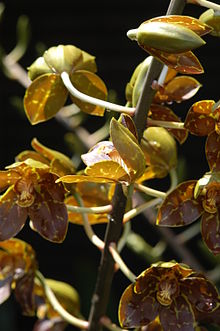Grammatophyllum speciosum
| Grammatophyllum speciosum | |
|---|---|

| |
| Scientific classification | |
| Kingdom: | Plantae |
| Clade: | Tracheophytes |
| Clade: | Angiosperms |
| Clade: | Monocots |
| Order: | Asparagales |
| Family: | Orchidaceae |
| Subfamily: | Epidendroideae |
| Genus: | Grammatophyllum |
| Species: | G. speciosum
|
| Binomial name | |
| Grammatophyllum speciosum | |
| Synonyms[2] | |
Grammatophyllum speciosum, also called giant orchid, tiger orchid, sugar cane orchid or queen of the orchids, is a species of orchid native to Indonesia. It is listed by the Guinness Book of World Records as the world's tallest orchid, with specimens recorded up to 7.62 metres (25 ft) in height.[3]
Description[]

It is an epiphytic and occasionally a lithophytic plant, forming spectacular root bundles. Its cylindric pseudobulbs can grow to a length of 2.5 m. It can grow to gigantic clusters weighing from several hundred kilograms to more than one ton.[4]
Each raceme can grow to a height of 3m, bearing up to eighty flowers, each 10 cm wide. The flowers are yellow colored with maroon or dark red spots. These flowers are remarkable, since the lowest flowers have no lip and these flowers function as for the entire inflorescence and continue to emit chemical scent to attract pollinators as flowers open in succession. It blooms only once every two to four years. This orchid can, however, remain in bloom for up to two months. In addition, this plant has been found to have potential medicinal benefits; for example one research article by Harikarnpakdee and Chowjarean found it specifically aided in wound healing in humans.[5]
Common names[]

- Giant orchid, not to be confused with Orthochilus ecristatus (Fernald) Rolfe[6][7] or ,[8][9] both of which are also commonly called the giant orchid.
- Tiger orchid, not to be confused with Rossioglossum grande or Maxillaria species, both are also called tiger orchid.
- Queen of the orchids, not to be confused with Cattleya species
- Sugar cane orchid, for its resemblance to a sugarcane plant of the genus Saccharum
Distribution and habitat[]
It is native to New Guinea, Thailand, Indonesia, Malaysia and Philippines, growing in crotches of large trees on exposed areas of the lowland tropical rainforest.[10]
Ecology[]
A giant orchid weighing two tons was one of the highlights in the 1851 exhibition at the Crystal Palace in London.
Because of its enormous size, it is rarely cultivated as this species is usually too large to be accommodated in most greenhouses. Cultivated specimens of this species are always grown as terrestrials, as the plants grow as both an epiphyte and terrestrial in habitat.[11]
References[]
- ^ "Grammatophyllum speciosum". World Checklist of Selected Plant Families (WCSP). Royal Botanic Gardens, Kew. Retrieved 2 Oct 2016 – via The Plant List.
- ^ "Grammatophyllum speciosum (synonyms)". World Checklist of Selected Plant Families (WCSP). Royal Botanic Gardens, Kew. Retrieved 2 Oct 2016.
- ^ Young, Mark C., ed. (1955). Guinness Book of World Records 1997. Guinness Publishing Ltd. pp. 42. ISBN 0-9652383-0-X.
- ^ Nancy Laws (2009) Orchid Breeding at Singapore Botanic Gardens Archived 2010-12-25 at the Wayback Machine Orchid Magazine
- ^ Harikarnpakdee, Saraporn; Chowjarean, Verisa (2018-10-21). "Grammatophyllum speciosum Ethanolic Extract Promotes Wound Healing in Human Primary Fibroblast Cells". International Journal of Cell Biology. 2018: 7836869. doi:10.1155/2018/7836869. ISSN 1687-8876. PMC 6215563. PMID 30420887.
- ^ "Plants Profile for Pteroglossaspis ecristata (giant orchid)". plants.usda.gov.
- ^ "Giant Orchid, Non-crested Eulophia (Pteroglossaspis ecristata) Information Page at Florida's Native and Naturalized Orchids". www.flnativeorchids.com.
- ^ "Archived copy". Archived from the original on 2010-12-02. Retrieved 2012-02-29.CS1 maint: archived copy as title (link)
- ^ "Archived copy". Archived from the original on 2010-12-25. Retrieved 2012-02-29.CS1 maint: archived copy as title (link)
- ^ Grammatophyllum speciosum Blume 1825 in The Internet Orchid Species Photo Encyclopedia at orchidspecies.com
- ^ Illustrated Encyclopedia of Orchids ISBN 0-88192-267-6
External links[]
![]() Media related to Grammatophyllum speciosum at Wikimedia Commons
Media related to Grammatophyllum speciosum at Wikimedia Commons
- Orchids of Thailand
- Orchids of Malaysia
- Orchids of New Guinea
- Orchids of Indonesia
- Grammatophyllum
- Orchids of the Philippines
- Epiphytic orchids
